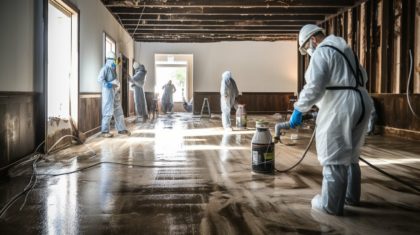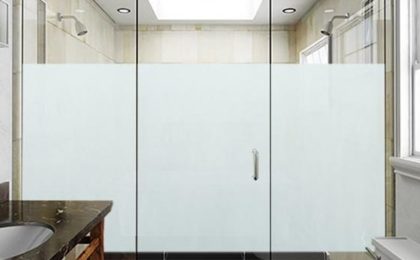Any time may bring on water damage, leaving homeowners with a potentially hazardous and frustrating mess. Water infiltration may seriously harm your home and foster the growth of mold, whether it is from a busted pipe, a leaking roof, or natural calamities like flooding. Properly identifying and addressing the source of water damage is critical to ensuring effective restoration and preventing future issues.
Recognizing the Signs of Water Damage
Early detection of water damage can spare you expensive restorations and significant repairs. Some signs are obvious, while others might be more subtle. Here are some common indicators of water damage in your home:
Visible Stains and Discoloration
Stains or discolorations on walls, ceilings, or floors are among the earliest indications of water damage. These marks can range from light yellow to dark brown, indicating a persistent water issue. Pay close attention to areas around windows, doors, and roofs where water might seep in.
Warped or Buckled Floors
Wooden flooring may bend or distort when wet. Your flooring is clearly showing signs of moisture penetration if you observe uneven or spongy regions. This can occur in any type of flooring, including hardwood, laminate, and even tiles, where water seeps through the grout.
Musty Odors
A persistent musty smell is often a telltale sign of mold or mildew, which thrive in damp conditions. If you smell a musty odor, especially in basements, attics, or bathrooms, it’s crucial to investigate further to identify any hidden water damage.
Peeling or Bubbling Paint and Wallpaper
When water gets behind paint or wallpaper, it can cause the surface to peel, bubble, or blister. This often indicates a leak within the walls or ceiling that needs to be addressed immediately.
Mold Growth
Mold can be black, green, or white in appearance, and it often thrives in moist, dark places. Mold not only damages surfaces but also poses significant health risks. Spotting mold on walls, ceilings, or floors necessitates prompt action to eliminate the moisture source and remediate the mold.
Identifying the Source of Water Damage
Finding the root cause of water damage is essential for effective restoration. Here are some common sources of water damage and how to identify them:
Plumbing Issues
Leaky pipes, burst hoses, and malfunctioning appliances are frequent causes of water damage. Regularly inspect visible pipes and hoses for signs of leaks or corrosion. If you notice a sudden drop in water pressure or unexplained wet spots, it might be due to a hidden plumbing issue.
Roof Leaks
Water damage to the attic or higher levels is frequently the result of roof leaks. Check for broken flashing, blocked gutters, and missing shingles on your roof.Water stains on the ceiling or walls directly beneath the roof indicate a leak that needs immediate attention.
Foundation Cracks
Water may seep into your home through walls in your basement or foundation. Check for visible cracks and signs of water intrusion, such as damp spots or efflorescence (a white, powdery substance on walls). These signs suggest that water is infiltrating through the foundation.
HVAC Systems
Water damage can result from HVAC (heating, ventilation, and air conditioning) systems that are not maintained correctly or that malfunction. Condensation from air conditioners, leaks from boilers, or clogged drainage lines can result in water damage. Regular maintenance and inspections of HVAC systems can prevent these issues.
Natural Disasters
Flooding, heavy rains, and storms can cause significant water damage. After a natural disaster, inspect your property thoroughly for water intrusion. Basements and ground floors are particularly vulnerable to flooding and should be checked for standing water and saturation.
Addressing Water Damage for Effective Restoration
As soon as the cause of the water damage has been located, you must act quickly to stop more damage and start the repair procedure. Here’s a step-by-step guide to addressing water damage effectively:
Stop the Water Source
Cutting off the water supply is the first step in treating water damage. This might entail patching a roof leak, repairing a leaky pipe, or cutting off the main water supply. Stopping the water flow prevents additional water from entering your home and causing further damage.
Remove Standing Water
Use pumps, wet vacuums, and mops to remove standing water. This process needs to be done quickly to prevent water from soaking into floors, walls, and furniture. In severe cases, professional equipment may be required to remove large volumes of water effectively.
Dry the Affected Area
Drying out the affected area is essential to prevent mold growth and further damage. Use fans, dehumidifiers, and open windows to increase air circulation and speed up the drying process. Professional drying equipment can be highly effective in thoroughly drying out your home.
Clean and Disinfect
Water damage can introduce harmful bacteria and contaminants into your home. Clean and disinfect all affected areas, including walls, floors, and furniture. Use cleaning products specifically designed for water damage restoration to ensure that all pathogens are eliminated.
Repair and Restore
Once the area is dry and clean, begin the repair and restoration process. This might involve replacing damaged drywall, flooring, and insulation. Ensure that all repairs are done to prevent future water damage. In some cases, structural repairs may be necessary to restore the integrity of your home.
Monitor for Mold
Even after thorough cleaning and drying, it’s essential to monitor your home for any signs of mold. Mold can develop within 24 to 48 hours of water exposure, so continued vigilance is necessary. If mold is detected, professional remediation is often required to safely and effectively remove it.
The Importance of Professional Help
While some water damage restoration tasks can be handled by homeowners, involving professionals ensures thorough and effective restoration. Professionals have the experience, tools, and knowledge to address the full scope of water damage. They can identify hidden damage, thoroughly dry and disinfect affected areas, and perform necessary repairs to restore your home.
For those in Grand Rapids, seeking expert help in property restoration ensures that your home is restored to its pre-damage condition. Professionals can also assist with insurance claims, making the process smoother and less stressful.
Conclusion
Water damage can wreak havoc on your home, but identifying and addressing the source promptly can mitigate its impact. Recognizing the signs of water damage, identifying the source, and taking immediate action are crucial steps in effective restoration. While some tasks can be managed independently, professional assistance in property restoration in Grand Rapids ensures a thorough and successful recovery process, protecting your home and health from the hidden dangers of water damage.











